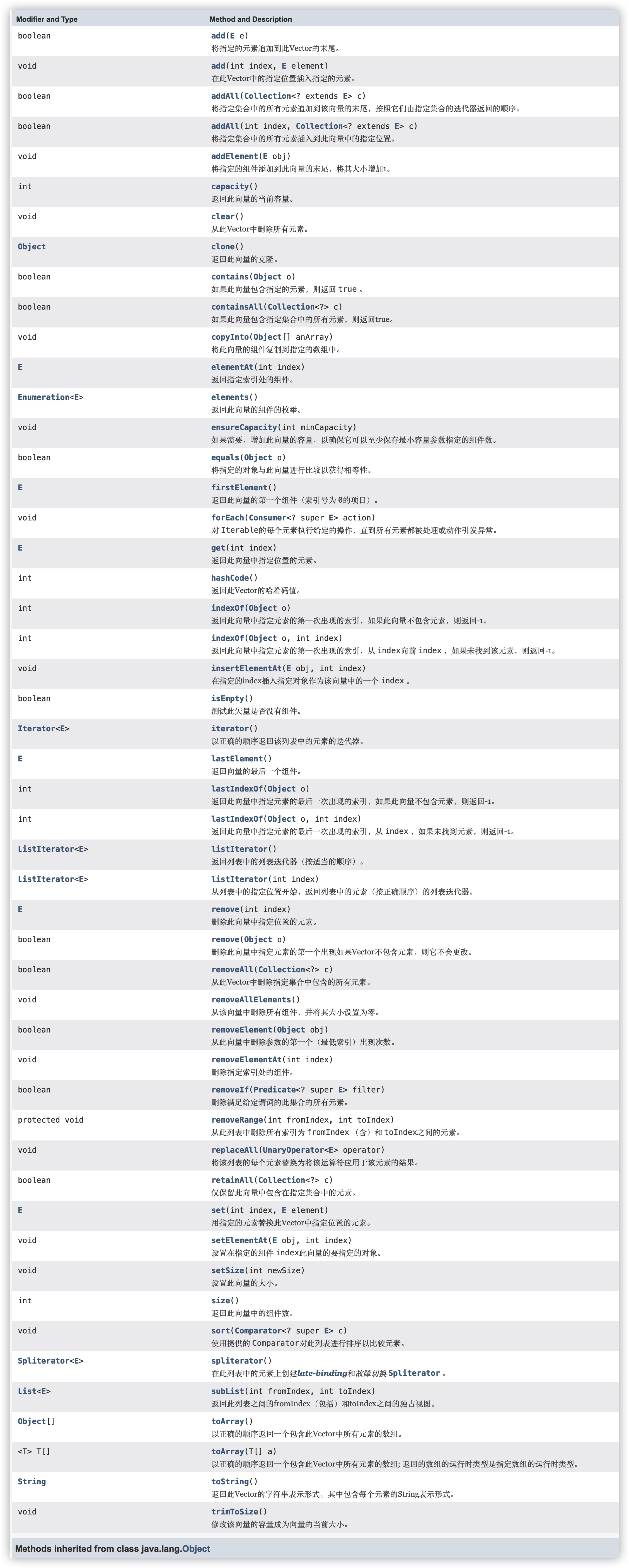本文最后更新于:December 17, 2021 pm
积土成山,风雨兴焉;积水成渊,蛟龙生焉;积善成德,而神明自得,圣心备焉。故不积跬步,无以至千里,不积小流无以成江海。齐骥一跃,不能十步,驽马十驾,功不在舍。面对悬崖峭壁,一百年也看不出一条裂缝来,但用斧凿,能进一寸进一寸,能进一尺进一尺,不断积累,飞跃必来,突破随之。
目录 介绍一些在竞赛中会用到的集合(容器),和使用方法。具体一些的用法可见《JAVA基础学习-集合》
而本文是快速介绍和一些基本用法。最主要的还是要知道有这些东西,比赛时针对不同的场景用不同的集合(容器)。因为我从C++转过来的,所以对C++里面的容器使用比较了解。而本文不仅会把JAVA中特有的集合介绍一下,还会把C++中的容器如何在JAVA中使用也介绍一下。因为,C++中的一些容器确实很好用而且用的还挺多,但在JAVA中却很少。
1.JAVA ArrayList、LinkedList、HashSet、TreeSet、LinkedHashSet、TreeMap、HashMap、LinkedHashMap 可见《JAVA基础学习-集合》
Map.Entry 一个Java中类似于C++中的Pair的容器。Map.Entry是Map的一个内部接口。配合Map使用。
主要的三个方法。
K getKey():
V getValue():
V setValue(V value)
示例:
1 2 3 4 5 6 7 8 9 10 11 12 13 14 15 16 17 18 19 20 21 22 23 24 25 public static void main (String[] args) throws Exception new Scanner(System.in);new LinkedHashMap<>();"C" ,3 );"A" ,1 );"B" ,2 );"D" ,4 );while (it.hasNext()){3 1 2 4
1 2 3 4 5 6 7 8 9 10 11 12 13 14 15 16 17 18 19 20 21 22 23 24 25 26 27 28 29 30 31 32 33 34 35 36 37 38 39 40 41 42 public static void main (String[] args) throws Exception new Scanner(System.in);new LinkedHashMap<>();"C" ,3 );"A" ,1 );"B" ,2 );"D" ,4 );while (it.hasNext()){23 );"修改后:" );while (it2.hasNext()){3 1 2 4 23 23 23 23
2.C++ 如何把C++中有的容器也用在JAVA中。需要注意的是,尽管C++中的容器在JAVA中也能使用,但是,并不是完全一样的,可能在JAVA中效率很低。这里只是说明在JAVA中也有,具体的使用情况根据实际而定。
2.1 Stack(栈) Stack 类表示后进先出(LIFO)的对象堆栈。它通过五个操作对类 Vector 进行了扩展 ,允许将向量视为堆栈。它提供了通常的 push 和 pop 操作,以及取堆栈顶点的 peek 方法、测试堆栈是否为空的 empty 方法、在堆栈中查找项并确定到堆栈顶距离的 search 方法。
因为它继承自Vector,那么它的实现原理是以数组实现堆栈的。如果要以链表方式实现堆栈可以使用LinkedList!Stack只有下面几个方法!由于Stack继承了Vector ,它也有Vector的API方法!
返回值
方法描述
booleanempty()测试此堆栈是否为空。
Epeek()查看栈顶元素。
Epop()删除栈顶元素,并将该元素作为返回值返回。
E`push(E item)添加元素到堆栈的顶部。与addElement(item)效果完全相同。
intsearch(Object o)返回一个对象在此堆栈上的基于1的位置。
来自Vector的方法有:add , add , addAll , addAll , addElement , capacity , clear , clone , contains , containsAll , copyInto , elementAt , elements , ensureCapacity , equals , firstElement , forEach , get , hashCode , indexOf , indexOf , insertElementAt , isEmpty , iterator , lastElement , lastIndexOf , lastIndexOf , listIterator , listIterator , remove , remove , removeAll , removeAllElements , removeElement , removeElementAt , removeIf , removeRange , replaceAll , retainAll , set , setElementAt , setSize , size , sort , spliterator , subList , toArray , toArray , toString , trimToSize
示例:
1 2 3 4 5 6 7 8 9 10 11 12 13 14 15 16 17 18 19 20 21 22 23 24 25 26 27 28 29 30 31 32 33 34 35 36 37 38 39 40 41 42 43 44 45 46 47 48 49 50 51 52 53 54 55 56 public static void main (String[] args) throws Exception new Scanner(System.in);new Stack<Integer>();"是空的" :"不是空的" );"现在Stack的大小为:" +s.size());"输入第一个元素:" );int a = sc.nextInt();"是空的" :"不是空的" );"现在Stack的大小为:" +s.size());"输入第二个元素:" );int b = sc.nextInt();"是空的" :"不是空的" );"现在Stack的大小为:" +s.size());"输入第三个元素:" );int c = sc.nextInt();"是空的" :"不是空的" );"现在Stack的大小为:" +s.size());"Stack中的元素有:" );while (!s.empty()){"删除了:" +s.pop()); 7 13 23 0 7 1 13 2 23 3 23 23 13 13 7 7
Stack的用法还是挺简单的。
2.2 Vector(向量) 方法有点多。。。。帖张图吧。还有就是vector是线程安全的,所以效率低。
就演示几个常用的就行,其他的可自行了解。
1 2 3 4 5 6 7 8 9 10 11 12 13 14 15 16 17 18 19 20 21 22 23 24 25 26 27 28 29 30 31 32 33 34 35 36 37 38 39 40 41 42 43 44 45 46 47 48 49 50 51 52 53 54 55 56 57 58 public static void main (String[] args) throws Exception new Scanner(System.in);new Vector<>();"aaaaaaaaa" );"bbbbbbbbb" );"cccc" );"1566165" );"元素总共有:" +vs.size());"for遍历输出:" );for (int i = 0 ; i < vs.size(); i++) {"================================" );"迭代器遍历输出:" );while (it.hasNext()){"================================" );"Enumeration遍历输出:" );while (es.hasMoreElements()){"==删除元素:========" );"cccc" ); 0 )); "删除后元素总共有:" +vs.size());4 for 遍历输出:1566165 1566165 1566165 2
2.3 Queue(队列)
Queue的6个方法分类:
压入元素(添加):add()、offer()
弹出元素(删除):remove()、poll()
获取队头元素(不删除):element()、peek()
LinkedList类实现了Queue接口,因此我们可以把LinkedList当成Queue来用。
1 2 3 4 5 6 7 8 9 10 11 12 13 14 15 16 17 18 19 20 21 22 23 24 25 26 27 28 29 30 31 32 33 import java.util.LinkedList;import java.util.Queue;public class Main public static void main (String[] args) new LinkedList<String>();"a" );"b" );"c" );"d" );"e" );for (String q : queue){"===" );"poll=" +queue.poll()); for (String q : queue){"===" );"element=" +queue.element()); for (String q : queue){"===" );"peek=" +queue.peek()); for (String q : queue){
2.4 PriorityQueue(优先队列)
返回值
方法描述
booleanadd(E e)将指定的元素插入到此优先级队列中。
voidclear()从此优先级队列中删除所有元素。
Comparator<? super E>comparator()返回用于为了在这个队列中的元素,或比较null如果此队列根据所述排序natural ordering的元素。
booleancontains(Object o)如果此队列包含指定的元素,则返回 true 。
Iterator<E>iterator()返回此队列中的元素的迭代器。
booleanoffer(E e)将指定的元素插入到此优先级队列中。
Epeek()检索但不删除此队列的头,如果此队列为空,则返回 null 。
Epoll()检索并删除此队列的头,如果此队列为空,则返回 null 。
booleanremove(Object o)从该队列中删除指定元素的单个实例(如果存在)。
intsize()返回此集合中的元素数。
Spliterator<E>spliterator()在此队列中的元素上创建*late-binding 和 失败快速* Spliterator
Object[]toArray()返回一个包含此队列中所有元素的数组。
<T> T[]toArray(T[] a)返回一个包含此队列中所有元素的数组; 返回的数组的运行时类型是指定数组的运行时类型。
常用方法:
peek()
示例:
1 2 3 4 5 6 7 8 9 10 11 12 13 14 15 16 17 18 19 20 21 22 23 24 25 26 27 28 29 30 31 32 33 34 static Comparator<Integer> cmp = new Comparator<Integer>() {public int compare (Integer e1, Integer e2) return e2 - e1;public static void main (String[] args) new PriorityQueue<>();3 );2 );4 );while (!q.isEmpty())" " );new PriorityQueue<>(cmp);3 );2 );4 );while (!qq.isEmpty())" " );
自定义类:
1 2 3 4 5 6 7 8 9 10 11 12 13 14 15 16 17 18 19 20 21 22 23 24 25 26 27 28 29 30 31 32 33 34 35 36 37 38 39 40 41 42 43 44 45 class Node public Node (int chang,int kuan) {this .chang=chang;this .kuan=kuan;int chang;int kuan;public class Test static Comparator<Node> cNode=new Comparator<Node>() {public int compare (Node o1, Node o2) if (o1.chang!=o2.chang)return o1.chang-o2.chang;else return o2.kuan-o1.kuan;public static void main (String[] args) new PriorityQueue<>(cNode);new Node(1 , 2 );new Node(2 , 5 );new Node(2 , 3 );new Node(1 , 2 );while (!q.isEmpty())"长: " +n.chang+" 宽:" +n.kuan);
优先队列遍历。PriorityQueue的iterator()不保证以任何特定顺序遍历队列元素。若想按特定顺序遍历,先将队列转成数组,然后排序遍历
Queue<Integer> q = new PriorityQueue<>(cmp);int [] nums= {2 ,5 ,3 ,4 ,1 ,6 };for (int i:nums)for (int i=nn.length-1 ;i>=0 ;i--)int )nn[i]+" " );
比较器生降序说明
Comparator<Object> cmp = new Comparator<Object>() {public int compare (Object o1, Object o2) return o1-o2;return o2-o1;
2.5 Pair 获取Key值:getKey()。
获取Value值:getValue()。
1 2 3 4 5 6 7 8 9 10 11 12 13 14 15 16 17 18 19 20 public static void main (String[] args) throws Exception new Scanner(System.in);new Pair<>("qwer" ,234 );new Pair[52 ];0 ] = new Pair<>("23" ,23 );1 ] = new Pair<>("2323" ,2323 );2 ] = new Pair<>("223343" ,2343 );for (int i = 0 ; i < 3 ; i++) {int t = pair[i].getValue();
2.6 Deque(双端队列) Deque是一个双端队列接口,继承自Queue接口,Deque的实现类是LinkedList、ArrayDeque、LinkedBlockingDeque,其中LinkedList是最常用的。
注意:Java堆栈Stack类已经过时,Java官方推荐使用Deque替代Stack使用。Deque堆栈操作方法:push()、pop()、peek()。
Deque有三种用途:
普通队列(一端进另一端出):
双端队列(两端都可进出)
堆栈
在将双端队列用作队列时,将得到 FIFO(先进先出)行为。将元素添加到双端队列的末尾,从双端队列的开头移除元素。
Queue方法 等效Deque方法
add(e)
addLast(e)
offer(e)
offerLast(e)
remove()
removeFirst()
poll()
pollFirst()
element()
getFirst()
peek()
peekFirst()
双端队列也可用作 LIFO(后进先出)堆栈。应优先使用此接口而不是遗留 Stack 类。在将双端队列用作堆栈时,元素被推入双端队列的开头并从双端队列开头弹出。
堆栈方法 等效Deque方法
push(e)
addFirst(e)
pop()
removeFirst()
peek()
peekFirst()
当作普通队列,就用普通队列的方法,当作双端队列就用双端队列的方法,当作堆栈就用堆栈的方法。
说明 offer,add 区别:
一些队列有大小限制,因此如果想在一个满的队列中加入一个新项,多出的项就会被拒绝。
这时新的 offer 方法就可以起作用了。它不是对调用 add() 方法抛出一个 unchecked 异常,而只是得到由 offer() 返回的 false。
poll,remove 区别:
remove() 和 poll() 方法都是从队列中删除第一个元素。remove() 的行为与 Collection 接口的版本相似, 但是新的 poll() 方法在用空集合调用时不是抛出异常,只是返回 null。因此新的方法更适合容易出现异常条件的情况。
peek,element区别:
element() 和 peek() 用于在队列的头部查询元素。与 remove() 方法类似,在队列为空时, element() 抛出一个异常,而 peek() 返回 null。


